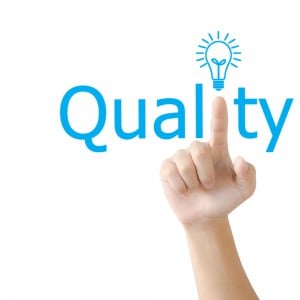

Many organizations are operating in losses due to poor quality of their offerings in the modern consumer driven world. Quality was seen as a way to combat the competition. Total Quality Management (TQM) is the art of managing the entire process to achieve excellence.
Total Quality Management and Continuous Improvement
TQM in an organization is defined by and supports the constant attainment of customer satisfaction through an integrated system of tools, techniques and training. TQM focuses on continuous improvement of organizational processes resulting in high quality products and services. The ideal goal of TQM is do things right the first time and every time. The customer is the ultimate judge of quality.
Quality cannot be improved without significant losses in productivity. It is imperative that the top management provide leadership and support for quality initiatives. Quality goals are moving targets and improving quality requires establishment of effective metrics. The three aspects of TQM are counting, customers and culture. Customer’s impression of quality begins from the initial contact with the company and continues throughout the life of the product. All departments of the organization must strive to improve the quality of their operations. Value based approach relies on service dimensions like reliability, responsiveness, assurance, empathy and tangibles.
TQM’s objective is continuous improvement of principles like customer focus, process improvement and total involvement. Elements of TQM speak about leadership, education and training, support structure, communications, rewards and recognition, and measurement or metrics. The critical success factors hinges on areas of managerial action and planning that must be practiced to achieve quality management in a business unit. The critical success factors are very essential for TQM and if it fails, the process gets terminated. Performance evaluation is based on quality, top management’s responsibility for quality performance, acceptance of responsibility for quality by major department heads, consideration of quality as first priority, discussing quality related issues in meetings and degree of comprehensiveness of quality plan. The ability of an organization to adapt to change in the business environment to capture best practices and achieve and maintain competitive performance is also critical for TQM to be successful. Input is company’s total quality effort and output is the level of performance of the plant.
“Quality is a lovable journey and not a destination”
Frequently Asked Questions (FAQs)
Enterprise asset management (EAM) involves the management of mission critical assets of an organization throughout each asset's lifecycle. EAM is used to plan, optimize, execute, and track the needed maintenance activities with the associated priorities, skills, materials, tools, and information. The aim is to optimize the quality and utilization of assets throughout their lifecycle, increase productive uptime and reduce operational costs.
Enterprise asset management (EAM) involves the management of the maintenance of physical assets of an organization throughout each asset's lifecycle. EAM is used to plan, optimize, execute, and track the needed maintenance activities with the associated priorities, skills, materials, tools, and information.
The software helps in effective maintenance of assets through preventive, predictive, shutdown and breakdown maintenance strategies. The system also helps enterprises mitigate equipment risks by enhanced safety standards. The streamlined operations and improved asset performance helps organizations increase their investment effectiveness.
EAM is important because it helps organizations track, assess, manage and optimize asset quality and reliability. Asset intensive Organizations have hundreds, thousands, even millions of assets which needs to be maintained to maximize / optimize life of these assets to increase the return on investment.
The key features of effective EAM are:
- Work management.
- Maintenance Strategies (Preventive/ Predictive / Breakdown / Shutdown).
- Planning and scheduling.
- Supply chain management.
- Health and safety.
- Mobility.
- Analytics.
- Improved Asset Health at reduced cost through data driven maintenance Programs
- Complete visibilityon entire maintenance data across Equipment, across Models, across Branches to aid in analysis & decision making such as to Repair or Replace the Equipment
- Insightful analysis of Inspection Data to improve customer satisfaction
- Effective maintenance management enhanced by predictive maintenance and inbuilt analytics
- Increased reliability and safety, keeps complete track of all the inspections & calibration schedules
- Mobile Application enables users to execute work while “in the field” leading to minimized non-productive time and increased productivity and reduces duplication of work and human errors in recording information.
- Quick turnaround time through Actionable Notification & Alerts for every process in real time and accessible anytime and anywhere.
- Improved Regulatory Part of asset management involves the implementation of better O&M practices, which can significantly improve compliance.
Asset Intensive companies under the following Industries :
- Ports
- Cement and Mining
- Utilities
- Fleet Maintenance
- Equipment Rental
- Other Manufacturing
- Real Estate & Infrastructure
- Power Generation
Contact us for a meeting and schedule a demo
This differs on case to case basis, based on the type of installation and unique industry specific requirements. Contact us for a meeting and schedule a demo.
This differs on case to case basis, based on the type of installation and unique industry specific requirements. Contact us for a meeting and schedule a demo.
Stay Connected, follow us on LinkedIn / Twitter to know more about EAM Software latest trends.

